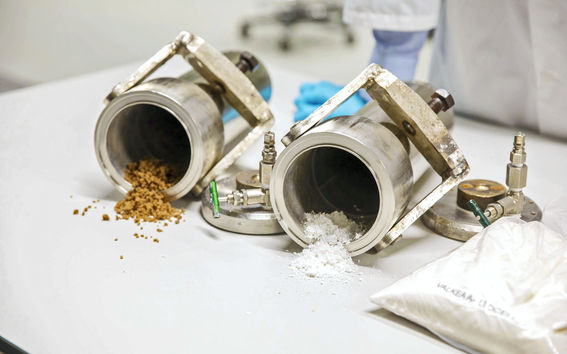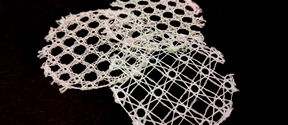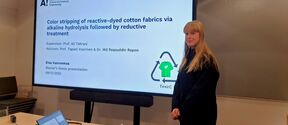What if the world’s cattle munched on Finnish wood?

In a way, it all got started by accident.
Professor Olli Dahl’s research group had an idea ten years ago: pulp mills that were suffering from the transition affecting the Finnish forest industry could be turned into biofuel factories. Instead of dissolving wood pulp, they would use paper pulp directly as a raw material, with manufacturing carried out in high temperatures and employing diluted acid hydrolysis, i.e. a very small amount of sulphuric acid.
“What came out was sugars for ethanol, as had been intended, but also some pulp mass, which would not dissolve even after numerous hydrolysis phases,” Olli Dahl says.
The stubborn mass turned out to be microcrystalline cellulose or MCC. It is valuable stuff, which had earlier been made only from dissolving wood pulp at small production units. As a tonne of MCC can, depending on quality, cost up to €6,000, it has been utilised mostly as a pharmaceutical filling agent. Dahl and his partners quickly investigated the patent situation and found out that nobody else anywhere in the world had manufactured MCC using the same method and on the scale of a pulp mill.
“We also realised that the output of just one facility the size of the Kemijärvi mill would flood the market unless we also developed new use applications.”
Like doping for cows
One potential high-volume user for MCC is the animal feed industry. Pastures and the growing of fodder consume up to a quarter of the available land on our planet – often in areas where land is needed to grow plants that are edible for humans. For ruminants, MCC with its near 100% cellulose content is a real power food, which could be used to boost the energy content of fodder and thus reduce demand for other types of animal feed.
“This is almost like doping for cows,” Dahl says as he picks up a jar and pours out a pile of brown powder on the palm of his hand.
“This MCC contains lignin in addition to cellulose, that’s why it’s brown. It is extracted in a different part of the factory, and its manufacture creates no wastewater from bleaching.”
Cellulose can only be utilised for energy by ruminants, whose four-compartment stomachs can digest it. MCC passes straight through the digestive systems of animals with single-compartment stomachs, such as poultry and pigs, but they, too, can benefit from it as a dietary supplement that enhances wellbeing. Dahl reveals that chickens, which had consumed MCC in trials, ate less yet still grew more and were healthier.
“We assume that microcrystalline cellulose either absorbs harmful substances when passing through their digestive systems or, alternatively, the phenolic compounds of the lignin it contains are killing bacteria.”
At the moment, the South-Eastern Finland University of Applied Sciences in Mikkeli and the Natural Resources Institute Finland LUKE are studying what effects MCC has on ruminants. Similar trials on pigs and retrials on poultry are being planned with the University of Helsinki. If the clinical trials and trial use on farms are successful, the possibilities are substantial.
“Here in Finland, fodder has a high fibre content and the use of antibiotics is moderate. The situation is different internationally. In Southeast Asia, for example, there is practically no grass, which is why MCC would make a great additive to animal feed. We expect this to be a hit product particularly in China, where production animals are given more antibiotics than anywhere else in the world,” Dahl says.
Biogas for Central Europe
Dahl is not alone with his ideas. In December 2017, Aalto University entered into a cooperation agreement with paper and pulp industry equipment manufacturer Andritz Oy. The goal is to take AaltoCell™ technology to the global markets. The technology is efficient and environment-friendly, both trump cards in today’s world. AaltoCell™ consumes only one percent of the sulphuric acid needed for the traditional microcrystalline cellulose manufacturing method.
Furthermore, using paper pulp as a raw material saves the energy that would have been required to make dissolving wood pulp, while the heat needed for the process itself is extracted from the bark of the wood used to make the pulp.
A hundred kilos of basic paper pulp creates about ninety kilos of MCC and ten kilos of pure sugars.
“After the beginning, we realised that, instead of ethanol, the sugars should be used to make biogas, which has a much better heat value,” Dahl says and starts to enthusiastically sketch out a vision:
“There are a lot of pulp mills in Central Europe that are located close to major traffic flows. The raw material they consume consists of mixed broadleaf trees, which contains fibres of a pretty low quality for papermaking. Our method makes it possible to turn the entire mill into a biogas factory, which could serve passing traffic. This would also remove low-quality paper pulp from the market. And the digestate the process yields could be mixed with bark ash and then used in the planting of new forests. Finland is too sparsely populated for this idea to work here, but the factory’s forklifts and other gear could be powered by biogas, and timber transports would of course be done with biogas trucks.”
Safe local fibre
In addition to commercialisation, the agreement with Andritz Oy covers a multi-year research cooperation, which has the aim of identifying new use applications for microcrystalline cellulose in, for example, the textile industry. White MCC is in demand also in the manufacture of food products and natural food supplements.
“It’s like wheat flour, but with zero energy,” Dahl smiles and produces another jar, this time containing white powder. Add some to a sweet bun dough for a lighter treat or significantly boost the fibre content of your morning porridge by on sprinkling some MCC.
“Hunger does arise from an empty stomach. Add a decent spoonful to your porridge, and it will form a web in your belly, making you feel full – weight loss would be pretty much guaranteed.”
Dahl has an unambiguous message for anyone with safety concerns: there’s no need to worry. Every step of the manufacturing process is known in detail from the forest all the way to the jar.
“A lot of people eat various supplements with no knowledge whatsoever about where their fibres came from. This, on the other hand, has been researched and found to be totally free of all chemical traces and, to top it off, it’s Finnish – a truly local fibre.”
Text: Minna Hölttä. Photo: Eeva Suorlahti.
This article is published in the Aalto University Magazine issue 22 (issuu.com), April 2018.

Brown MCC could be a big hit in the animal feed industry. New use applications for white MCC are being sought in, for example, the food and textile industries. Photo: Mikko Raskinen.
Read more news

Learning Centre opening hours during Christmas and year-end holidays
Thank you for the past year and have a wonderful holiday season!
Smart textiles are reshaping our understanding of materials – and interspecies communication
The PAST-A-BOT research project, funded by the European Research Council (ERC), is developing soft, intelligent textiles that could one day function as rescue robots, sound-sensing agricultural fabrics, or assistive clothing. At the same time, the project aims to rethink the way we approach materials research.
Master’s student showcases efficient color stripping of cotton fabrics
On December 9, master’s thesis student Elsa Vuorenmaa from the Textile Chemistry Group presented the results of her research on color stripping of reactive-dyed cotton fabrics.






